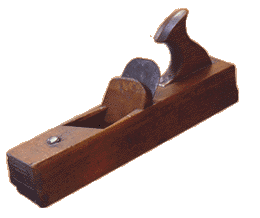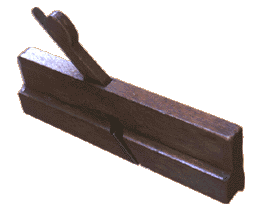| The planes below are all specialty planes. Comparatively few smooth and bench planes from the period survive. Bench planes would be in constant use dressing wood and would wear out quicker. |
|
Panel Raising Plane Yellow Birch, 12 7/8" long, signed "CE. Chelor". This plane is the primary tool used in frame and panel construction. The plane was used for planing down the sides of a board so that the edges would fit into a groove cut into a frame. The blade is skew, or angled, so the plane will cut perpendictular to the grain. The iron startling peg is where you hit the plane to "startle" the wedge and loosen it so that you can adjust the blade. This is a nice feature as it protects the plane body from getting to badly beaten up. Details |
|
Complex Molding Plane (Bead and cove) . 9 7/8" long. The shape that a molding planes cuts is called its profile. Molding planes come in thousands of varieties, flavors and sizes but all molding planes are constructed using a combination of basic profiles. You can create a molding several ways: By planing each part of a complex profile in a separate step using a simple molding plane for each part. Or by using a complex molding plane, such as this one where a bead and a cove are joined, and planing the entire molding at once. The latter method is saves steps and labor but you are restricted to the complex molding planes you have at hand but the former method uses simpler planes but requires a lot more time and skill to execute well. |
|
Bead molder. 9 7/8" long Signed Cesar Chelor. One of less than 6 Chelor planes signed with his entire name. |
|
1 1/4" Molding plane (Ogee and Astragal) 10" long. In superb condition, this plane is one of the best preserved Chelor planes known. How moulding planes are used. Details |



